Anti-Blast Performance of Polyurea-Coated Concrete Arch Structures
Abstract
:1. Introduction
2. Specimen Preparation and Materials
2.1. Geometrical Model Description
2.2. Geometrical Model Description
2.3. Material Model
2.3.1. Bars
2.3.2. Concrete
2.3.3. Polyurea
2.3.4. TNT
2.3.5. Air
3. Explosion Test and Simulation Validation
3.1. Experiment Test
3.2. Simulation Validation
3.2.1. Damage
3.2.2. Reflective Pressure
3.2.3. Acceleration
4. Further Numerical Investigation
4.1. Deformation Analysis
4.2. Vibration Analysis
4.2.1. Acceleration (Y-Direction, i.e., Vertical)
4.2.2. Resultant Acceleration
5. Conclusions and Future Work
- In this study, the failure pattern of concrete arch structures after blast load was dentified by experiment. The arch structure reinforced by polyurea is mainly fractured in oblique shear at the vault, indicating that the polyurea strengthening has shifted the damage pattern from bending damage to shear damage.
- By comparing the results of the numerical simulations with the data attained in current experiments, it is obvious that the simulation model is capable of predicting the damage of the arch structure and the dynamic data, providing a reference for future simulations of the dynamic response of concrete arch structures under blast loading.
- Polyurea in strengthened condition can lower the degree of deformation of the vault effectively, and increasing the thickness of the polyurea can further suppress the deformation. However, when the polyurea is strengthened to an extreme level, it becomes too thick (over 5 mm), and the anti-blast performance of the structure will not be enhanced significantly. When the thickness of the polyurea is defined, the enclosed-coating form of reinforcement has the best anti-blast properties. When polyurea is strengthened on the outer side of the arch, the arch structure has the worst explosion resistance.
- The thickness and location of the polyurea reinforcement have a considerable influence on the effect of vibration damping of the structure. Polyurea reinforcement in the middle of arch is a relatively effective method of vibration damping; however, increasing the thickness of the polyurea cannot guarantee a better vibration-damping effect.
Author Contributions
Funding
Institutional Review Board Statement
Data Availability Statement
Acknowledgments
Conflicts of Interest
References
- Karagiozova, D.; Nurick, G.N.; Langdon, G.S. Behaviour of sandwich panels subject to intense air blasts–Part 2: Numerical simulation. Compos. Struct. 2009, 91, 442–450. [Google Scholar] [CrossRef]
- Pham, T.M.; Hao, H. Effect of the plastic hinge and boundary conditions on the impact behavior of reinforced concrete beams. Int. J. Impact Eng. 2017, 102, 74–85. [Google Scholar] [CrossRef] [Green Version]
- Xia, Z.; Wang, X.; Fan, H. Blast resistance of metallic tube-core sandwich panels. Int. J. IMPact Eng. 2016, 97, 10–28. [Google Scholar] [CrossRef]
- Lam, K.Y.; Chun, L. Analysis of clamped laminated plates subjected to conventional blast. Compos. Struct. 1994, 29, 311–321. [Google Scholar] [CrossRef]
- De, A.; Morgante, A.N.; Zimmie, T.F. Numerical and physical modeling of geofoam barriers as protection against effects of surface blast on underground tunnels. Geotext Geomembranes 2016, 44, 1–12. [Google Scholar] [CrossRef] [Green Version]
- Shi, S.; Liao, Y.; Peng, X.; Liang, C.; Sun, J. Behavior of polyurea-woven glass fiber mesh composite reinforced RC slabs under contact explosion. Int. J. Impact. Eng 2019, 132, 103335. [Google Scholar] [CrossRef]
- Chen, H.; Zhou, J.; Fan, H. Dynamic responses of buried arch structure subjected to subsurface localized impulsive loading: Experimental study. Int. J. Impact Eng. 2014, 65, 89–101. [Google Scholar] [CrossRef]
- Guangkun, L.; Wei, W.; Ruichao, L. Deriving formulas of loading distribution on underground arch structure surface under close-in explosion. Eng. Fail. Anal. 2020, 115, 104608. [Google Scholar] [CrossRef]
- Alhadid, M.M.A.; Soliman, A.M.; Nehdi, M.L. Critical overview of blast resistance of different concrete types. Mag. Concr. Res. 2014, 66, 72–81. [Google Scholar] [CrossRef]
- Chen, W.; Hao, H. Experimental investigations and numerical simulations of multi-arch double-layered panels under uniform impulsive loadinSG. Int. J. Impact Eng. 2014, 63, 140–157. [Google Scholar] [CrossRef]
- Buchan, P.A.; Chen, J.F. Blast resistance of FRP composites and polymer strengthened concrete and masonry structures–A state-of-the-art review. Compos. Part B Eng. 2007, 38, 509–522. [Google Scholar] [CrossRef]
- Zhang, C.; Gholipour, G.; Mousavi, A.A. Blast loads induced responses of RC structural members: State-of-the-art review. Compos. Part B Eng. 2020, 195, 108066. [Google Scholar] [CrossRef]
- Draganićl, H.; Gazić, G.; Varevac, D. Experimental investigation of design and retrofit methods for blast load mitigation–A state-of-the-art review. Eng. Struct. 2019, 190, 189–209. [Google Scholar] [CrossRef]
- Fornůsek, J.; Zatloukal, J. Numerical Study of the Influence of Internal Blast on the Earth Covered Composite Arch. Advanced Mater. Res. 2014, 982, 84–89. [Google Scholar] [CrossRef]
- Wang, B.; Wang, P.; Chen, Y. Blast responses of CFRP strengthened autoclaved aerated cellular concrete panels. Constr. Build. Mater. 2017, 157, 226–236. [Google Scholar] [CrossRef]
- Zhang, X.; Wang, P.; Jiang, M. CFRP strengthening reinforced concrete arches: Strengthening methods and experimental studies. Compos. Struct. 2015, 131, 852–867. [Google Scholar] [CrossRef]
- Wang, P.; Jiang, M.; Zhou, J. Spalling in concrete arches subjected to shock wave and CFRP strengthening effect. Tunn. Undergr. Space Technol. 2018, 74, 10–19. [Google Scholar] [CrossRef]
- Kong, X.; Qi, X.; Gu, Y. Numerical evaluation of blast resistance of RC slab strengthened with AFRP. Constr. Build. Mater. 2018, 178, 244–253. [Google Scholar] [CrossRef]
- Qasrawi, Y.; Heffernan, P.J.; Fam, A. Performance of concrete-filled FRP tubes under field close-in blast loading. J. Compos. Constr. 2015, 19, 04014067. [Google Scholar] [CrossRef]
- Hu, Y.; Chen, L.; Fang, Q. Study of CFRP retrofitted RC column under close-in explosion. Eng. Struct. 2021, 227, 111431. [Google Scholar] [CrossRef]
- Ramamurthy, K.; Nambiar, E.K.K.; Ranjani, G.I.S. A classification of studies on properties of foam concrete. Cem. Concr. Compos. 2009, 31, 388–396. [Google Scholar] [CrossRef]
- Maazoun, A.; Matthys, S.; Belkassem, B. Experimental analysis of CFRP strengthened reinforced concrete slabs loaded by two independent explosions. Multidiscip. Digit. Publ. Inst. Proceedings SG. 2018, 2, 436. [Google Scholar]
- Maazoun, A.; Matthys, S.; Vantomme, J. Literature review on blast protection by externally bonded FRP reinforcement. In Proceedings of the COST TU1207 End-of-Action Conference, Budapest, Hungary, 3–5 April 2017; pp. 1–6. [Google Scholar]
- Chen, Y.; Wang, B.; Zhang, B. Polyurea coating for foamed concrete panel: An efficient way to resist explosion. Def. Technol. 2020, 16, 136–149. [Google Scholar] [CrossRef]
- Gardner, N.; Wang, E.; Kumar, P. Blast mitigation in a sandwich composite using graded core and polyurea interlayer. Exp. Mech. 2012, 52, 119–133. [Google Scholar] [CrossRef]
- Wang, W.; Huo, Q.; Yang, J.C. Damage analysis of POZD coated square reinforced concrete slab under contact blast. Def. Technol. 2022, 18, 12. [Google Scholar] [CrossRef]
- Wang, J.; Ren, H.; Wu, X. Blast response of polymer-retrofitted masonry unit walls. Compos. Part B Eng. 2017, 128, 174–181. [Google Scholar] [CrossRef]
- Ackland, K.; Anderson, C.; Ngo, T.D. Deformation of polyurea-coated steel plates under localised blast loading. Int. J. Impact Eng. 2013, 51, 13–22. [Google Scholar] [CrossRef] [Green Version]
- Liu, Y.; Wang, P.; Jin, F. Blast responses of polyurea-coated concrete arches. Arch. Civ. Mech. Eng. 2021, 21, 1–15. [Google Scholar] [CrossRef]
- Zhao, C.; Tang, Z.; Wang, P.; Feng, J. Blast responses of shallow-buried prefabricated modular concrete tunnels reinforced by BFRP-steel bars. Undergr. Space 2022, 7, 184–198. [Google Scholar] [CrossRef]
- Wang, W.; Wei, G.; Yang, J. Study on antiexplosion performance of reinforced concrete slabs strengthened with POZD coated steel plate under contact explosion. Eng. Fail. Anal. 2022, 140, 106589. [Google Scholar] [CrossRef]
- Liu, Z.; Zhao, X.; Liu, D.; Wang, G.; Shi, M. Comparative Study on Blast Damage Features of Reinforced Concrete Slabs with Polyurethane Sacrificial Cladding Based on Different Numerical Simulation Methods. Polymers 2022, 14, 3857. [Google Scholar] [CrossRef]
- Liu, Z.; Wu, J.; Yu, J. Damage assessment of normal reinforced concrete panels strengthened with polyurea after explosion. Case Stud. Constr. Mater. 2022, 17, e01695. [Google Scholar] [CrossRef]
- Wu, J.; Zhou, Y.; Zhang, R. Numerical simulation of reinforced concrete slab subjected to blast loading and the structural damage assessment. Eng. Fail. Anal. 2020, 118, 104926. [Google Scholar] [CrossRef]
- Wu, J. Experimental and numerical investigation of normal reinforced concrete panel strengthened with polyurea under near-field explosion. J. Build. Eng. 2021, 2, 103763. [Google Scholar] [CrossRef]
- Pan, L.; Hao, H.; Cui, J. Numerical study on dynamic properties of rubberised concrete with different rubber contents. Def. Technol. 2022, accepted. [Google Scholar] [CrossRef]
- Zhao, C.; He, K.; Zhi, L. Blast behavior of steel-concrete-steel sandwich panel: Experiment and numerical simulation. Eng. Struct. 2021, 246, 112998. [Google Scholar] [CrossRef]
- Alanon, A.; Cerro-Prada, E.; Vazquez-Gallo, M.; Santos, A.P. Mesh size effect on finite- element modeling of blast-loaded reinforced concrete slab. Eng. Comput. 2018, 34, 649–658. [Google Scholar] [CrossRef]
- Khoe, Y.; Weerheijm, J. Limitations of smeared crack models for dynamic analysis of concrete Yoeng Sin Khoe and Jaap Weerheijm. In Proceedings of the 12th International LS-DYNA Users Conference, Constitutive Models, Detroit, MI, USA, 3–5 June 2017; Volume 6, pp. 1–14. [Google Scholar]
- Reifarth, C.; Castedo, R.; Santos, A.P. Numerical and experimental study of externally reinforced RC slabs using FRPs subjected to close-in blast loads. Int. J. Impact Eng. 2021, 156, 103939. [Google Scholar] [CrossRef]
- Castedo, R.; Santos, A.P.; Alaón, A. Numerical study and experimental tests on full-scale RC slabs under close-in explosions. Eng. Struct. 2021, 231, 111774. [Google Scholar] [CrossRef]
- Rajkumar, D. Numerical study on parametric analysis of reinforced concrete column under blast loading. J. Perform. Constr. Facil. 2021, 34, 04019102. [Google Scholar] [CrossRef]
- Yan, J.B.; Zhang, W. Numerical analysis on steel-concrete-steel sandwich plates by damage plasticity model: From materials to structures. Constr. Build Mater. 2017, 149, 801–815. [Google Scholar] [CrossRef]
- Abedini, M.; Zhang, C. Performance assessment of concrete and steel material models in ls-dyna for enhanced numerical simulation, a state of the art review. Arch. Comput. Methods Eng. 2021, 28, 2921–2942. [Google Scholar] [CrossRef]
- Yin, X.; Li, Q.; Xu, X. Investigation of continuous surface cap model (CSCM) for numerical simulation of strain-hardening fibre-reinforced cementitious composites against low-velocity impacts. Compos. Struct. 2023, 304, 116424. [Google Scholar] [CrossRef]
- Yin, X.; Li, Q.; Chen, B. An improved calibration of Karagozian & Case concrete/cementitious model for strain-hardening fibre-reinforced cementitious composites under explosion and penetration loadings. Cem. Concr. Compos. 2023, 137, 104911. [Google Scholar]
- Su, Q.; Wu, H.; Sun, H.S. Experimental and numerical studies on dynamic behavior of reinforced UHPC panel under medium-range explosions. Int. J. Impact Eng. 2021, 148, 103761. [Google Scholar] [CrossRef]
- Liu, S.; Chen, H.; Liu, Y. Vibration attenuation of meta-mortar with spring-mass resonators. Def. Technol. 2022, accepted. [Google Scholar] [CrossRef]
- Studziński, R.; Gajewski, T.; Malendowski, M. Blast test and failure mechanisms of soft-core sandwich panels for storage halls applications. Materials 2020, 14, 70. [Google Scholar] [CrossRef]
- Chen, G.; Cheng, Y.; Zhang, P.; Liu, J.; Chen, C.; Cai, S. Design and modelling of auxetic double arrowhead honeycomb core sandwich panels for performance improvement under air blast loading. Sandw. Struct. Mater 2021, 23, 3574–3605. [Google Scholar] [CrossRef]
- Jin, H.; Hao, H.; Chen, W. Influence of Bandgap on the Response of Periodic Metaconcrete Rod Structure under Blast Load. J. Mater. Civ. Eng. 2022, 34, 04022284. [Google Scholar] [CrossRef]
- Wanchoo, P.; Matos, H.; Rousseau, C.E. Investigations on air and underwater blast mitigation in polymeric composite structures–A review. Compos. Struct. 2021, 263, 113530. [Google Scholar] [CrossRef]

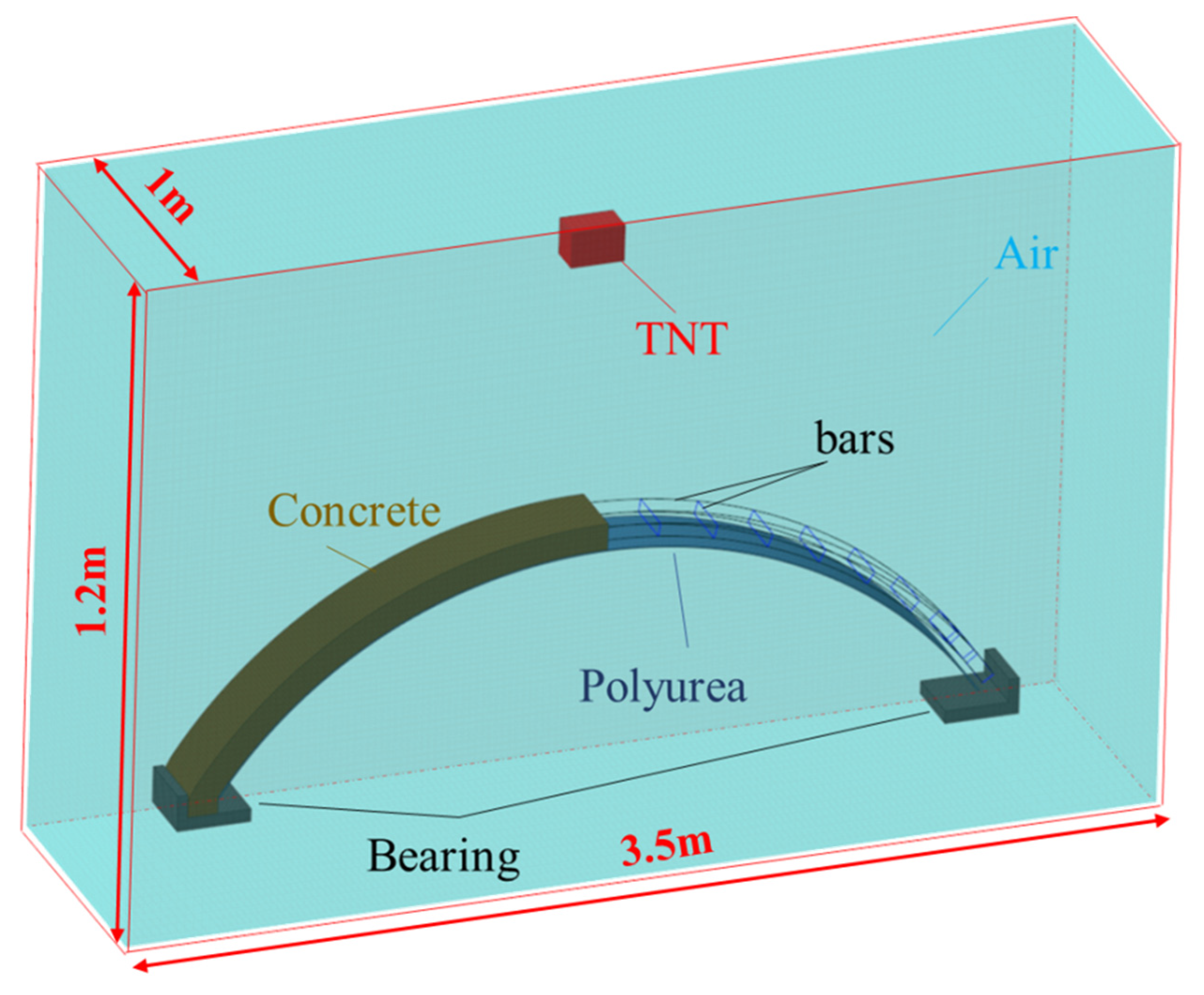


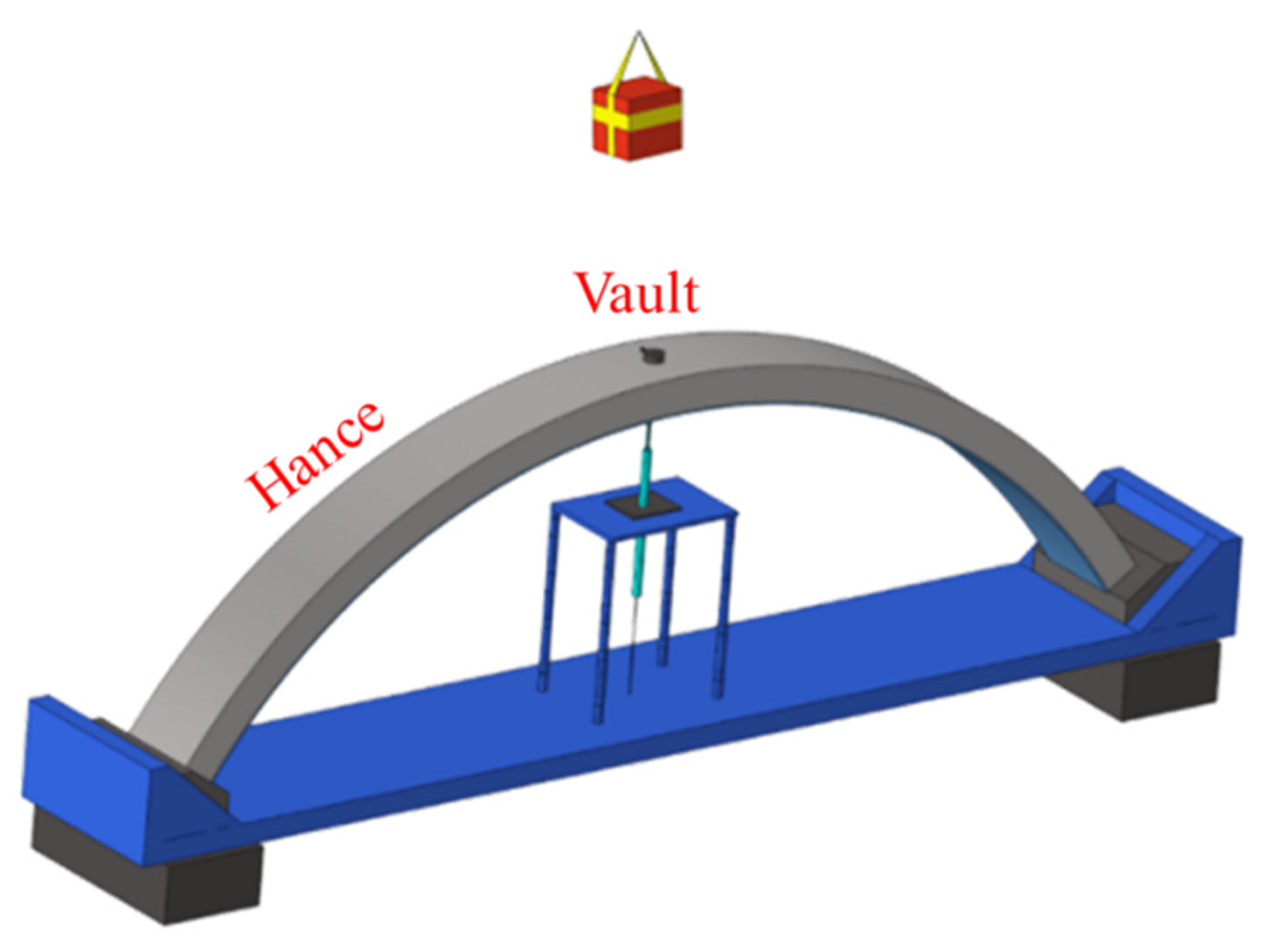
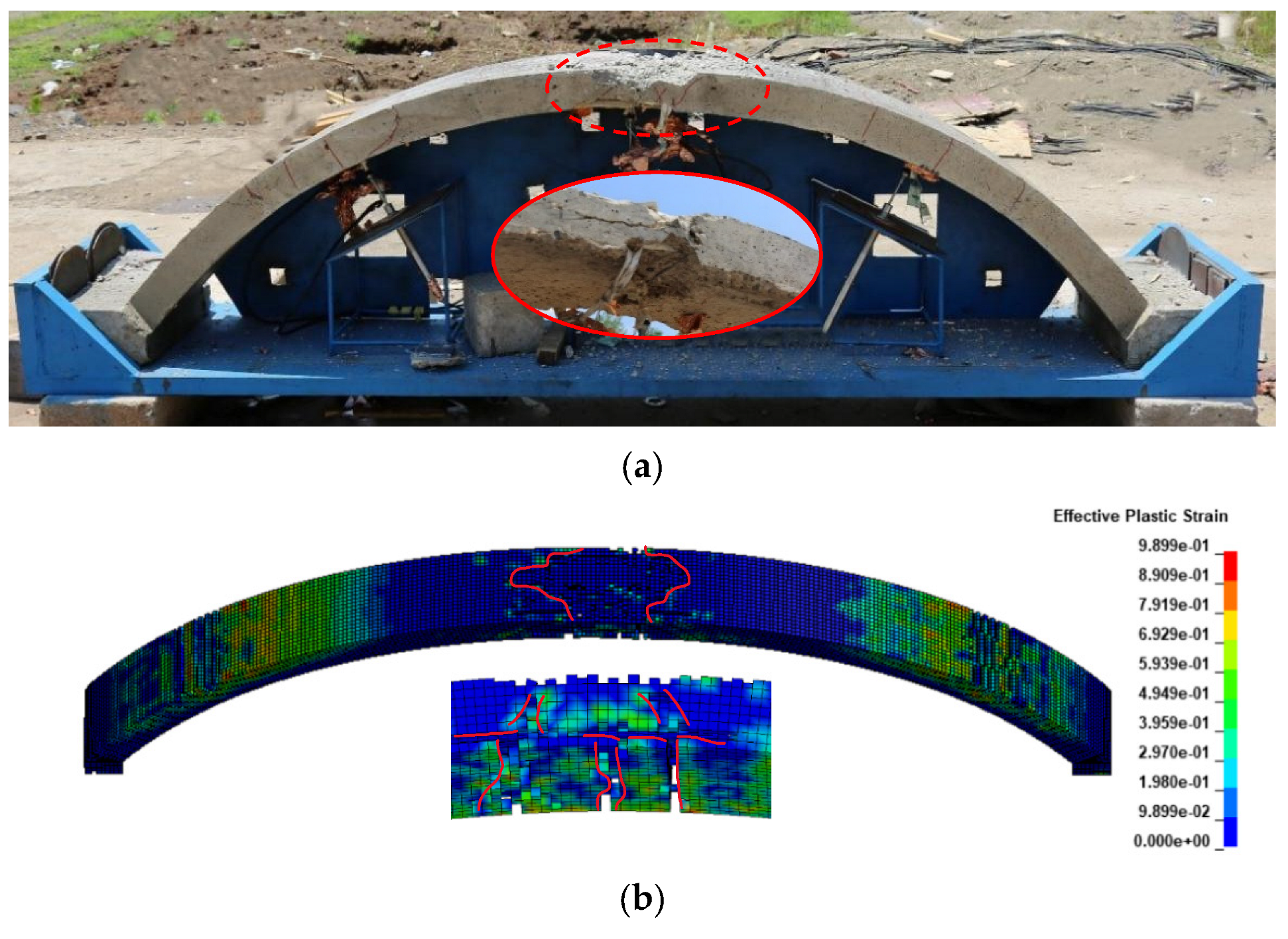


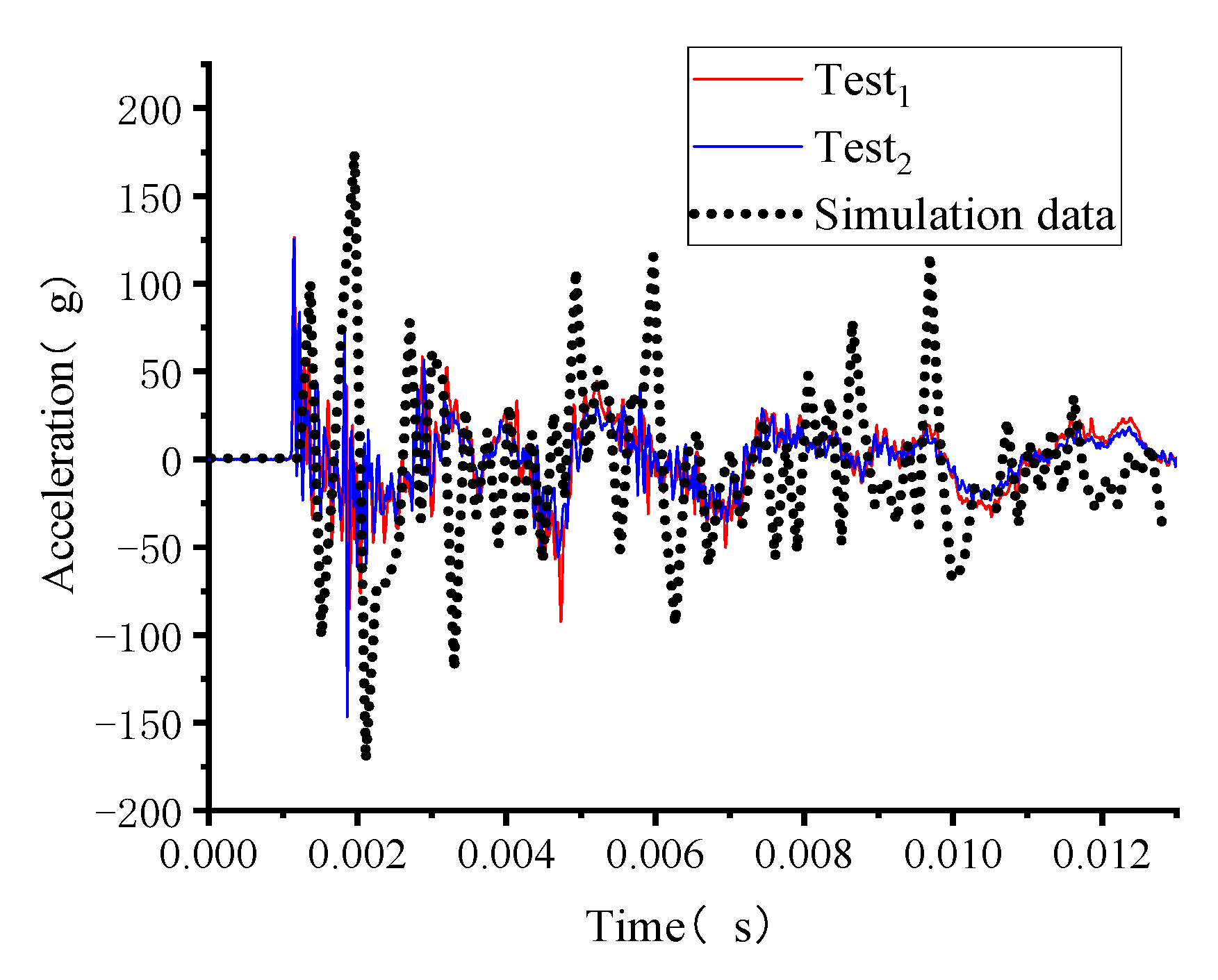

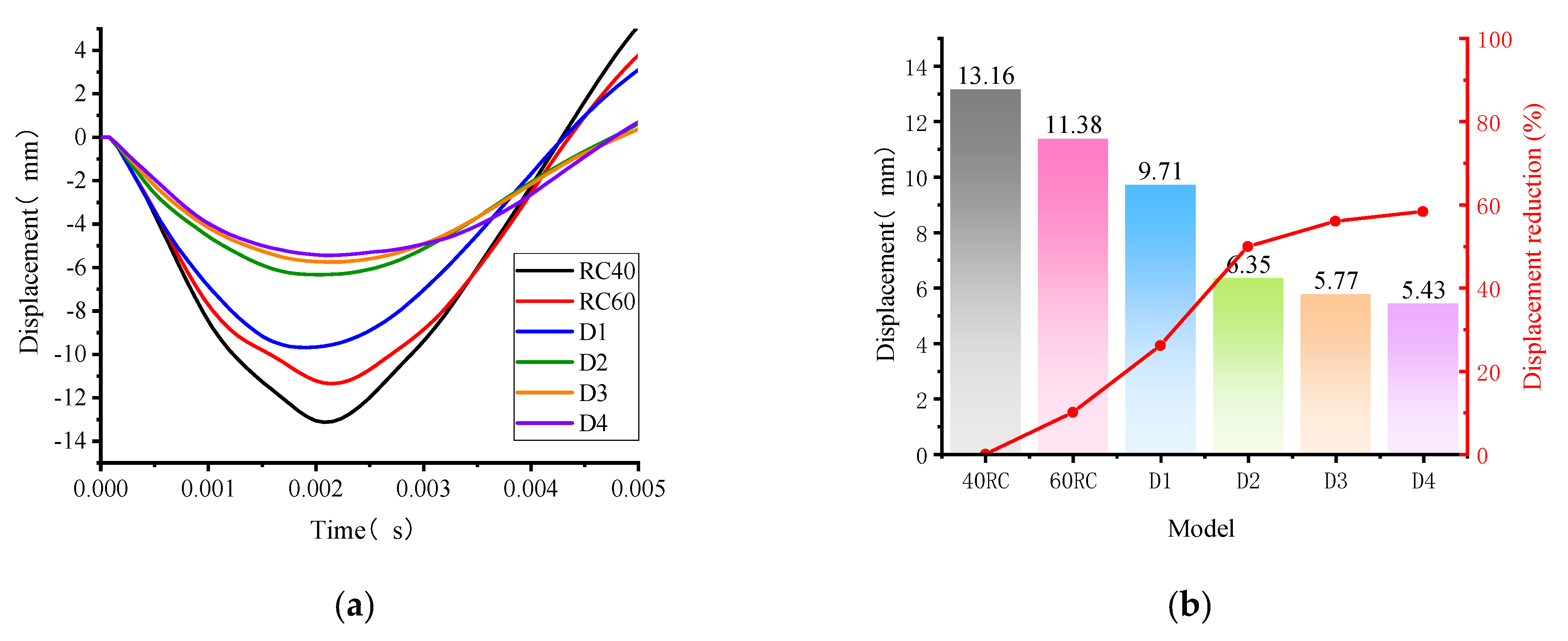
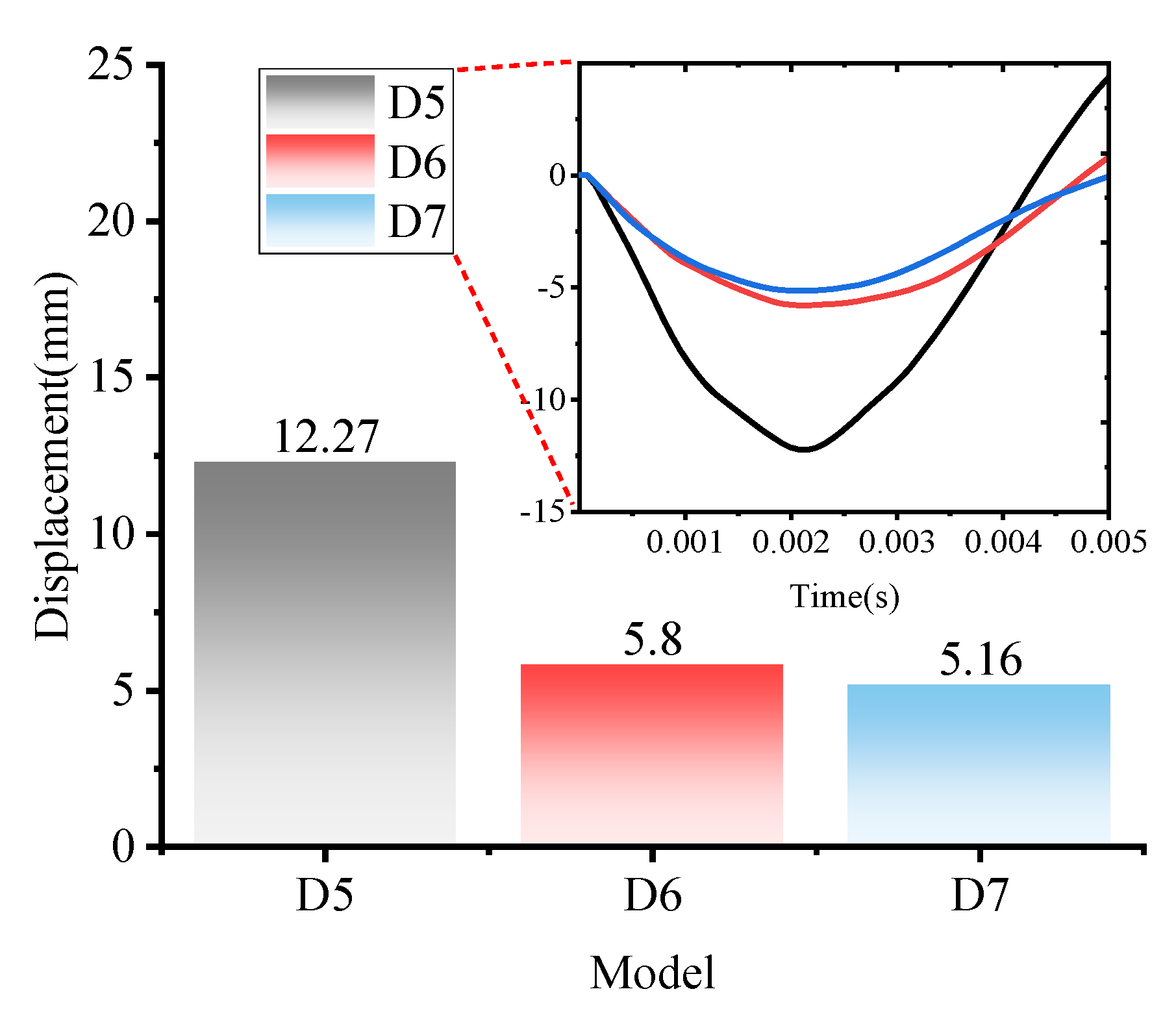


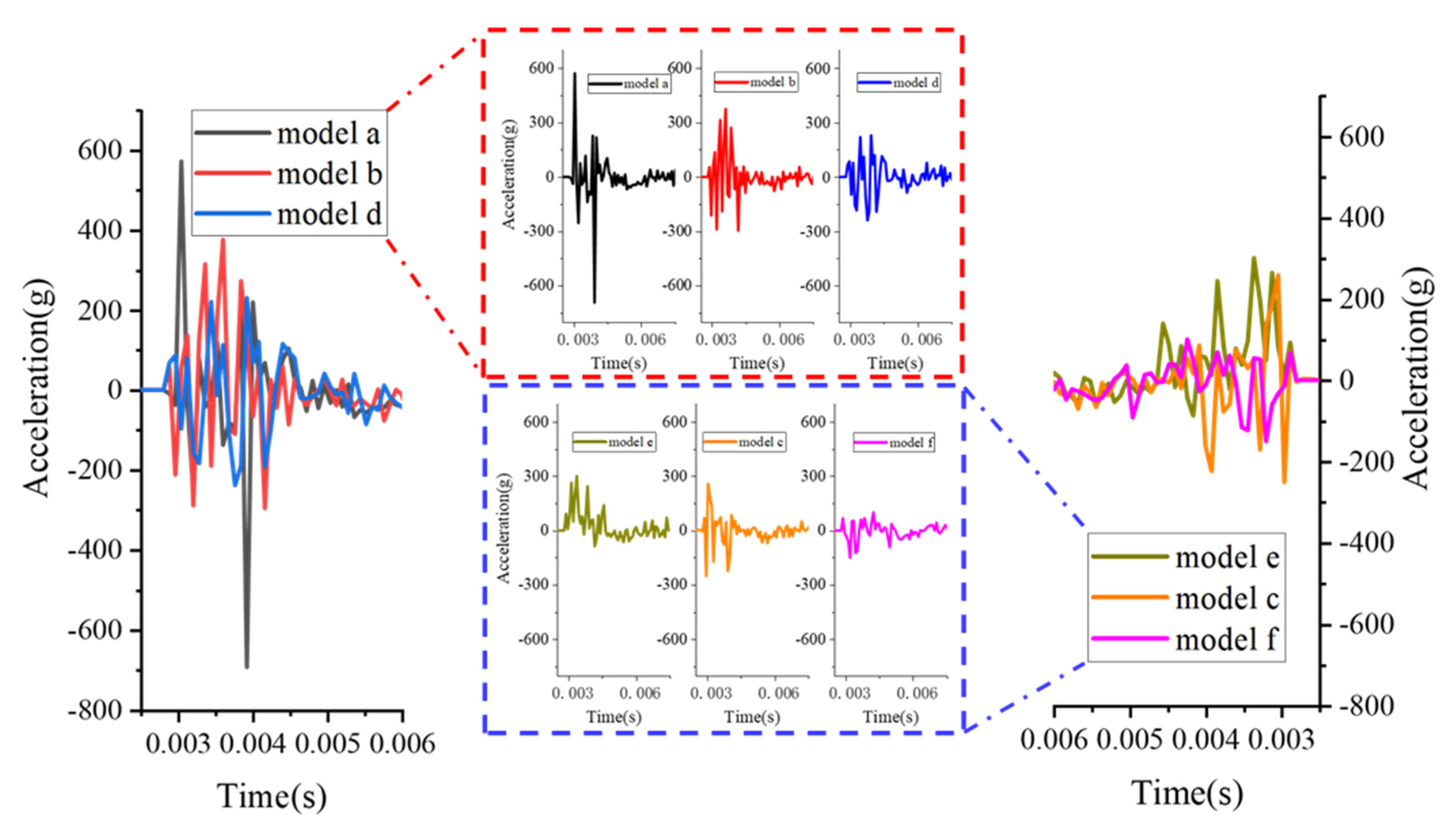

| Concrete | Reinforcing Bar | ||||||||
|---|---|---|---|---|---|---|---|---|---|
| Unconfined compressive strength | Tensile strength | Elastic modulus | Ultimate tensile strength | Yield strength | Elastic modulus | C | P | ||
| 24.6 MPa | 1.95 MPa | 21 GPa | 455 MPa | 335 MPa | 200 GPa | 40.4 s−1 | 5 | ||
| Polyurea | |||||||||
| Density (g/cm) | Shore hardness A (°) | Poisson rate | Fracture strain | Tensile strength (MPa) | Tear strength (N/mm) | Abrasive resistance (750 g, 500 r) | Gelation time (s) | ||
| 1.2 | 90 | 0.4 | 350% | 18 | 55 | 30 mg | 10–20 | ||
| ρ (kg/m3) | IRATE | ERODE | f c (MPa) | UNIT |
|---|---|---|---|---|
| 2400 | 1 | 1.0 | 24.6 | 4 |
| ρ (kg/m3) | D (m/s) | Pcj (Gpa) | A (Gpa) | B (Gpa) | R1 | R2 | ω | E0 (J/m3) | V |
|---|---|---|---|---|---|---|---|---|---|
| 1631 | 6718 | 18.5 | 374 | 3.75 | 4.15 | 0.9 | 0.35 | 7 × 109 | 1.0 |
| ρ (kg/m3) | C1 | C4 | C5 | E0 (J/m3) | V |
|---|---|---|---|---|---|
| 1.293 | −1 × 105 | 0.4 | 0.4 | 2.5 × 105 | 1.0 |
| Arch | Thickness of Polyurea | TNT (kg) | Stand-off Distance (m) | Scaled Distance (m/kg1/3) |
|---|---|---|---|---|
| A1 | 5 mm | 1 | 1.50 | 1.50 |
| A2 | 0 | 2 | 0.85 | 0.67 |
| A3 | 5 mm | 2 | 0.85 | 0.67 |
| B1 | 5 mm | 0.1 | 1.00 | 2.15 |
Disclaimer/Publisher’s Note: The statements, opinions and data contained in all publications are solely those of the individual author(s) and contributor(s) and not of MDPI and/or the editor(s). MDPI and/or the editor(s) disclaim responsibility for any injury to people or property resulting from any ideas, methods, instructions or products referred to in the content. |
© 2023 by the authors. Licensee MDPI, Basel, Switzerland. This article is an open access article distributed under the terms and conditions of the Creative Commons Attribution (CC BY) license (https://creativecommons.org/licenses/by/4.0/).
Share and Cite
Yue, Z.; Zhou, J.; Kong, X.; Xu, Y.; Chen, Y.; Wang, B.; Huang, Y.; Wang, P. Anti-Blast Performance of Polyurea-Coated Concrete Arch Structures. Polymers 2023, 15, 1263. https://doi.org/10.3390/polym15051263
Yue Z, Zhou J, Kong X, Xu Y, Chen Y, Wang B, Huang Y, Wang P. Anti-Blast Performance of Polyurea-Coated Concrete Arch Structures. Polymers. 2023; 15(5):1263. https://doi.org/10.3390/polym15051263
Chicago/Turabian StyleYue, Zhengyuan, Jiannan Zhou, Xinli Kong, Ying Xu, Yishun Chen, Bo Wang, Yimiao Huang, and Peng Wang. 2023. "Anti-Blast Performance of Polyurea-Coated Concrete Arch Structures" Polymers 15, no. 5: 1263. https://doi.org/10.3390/polym15051263





